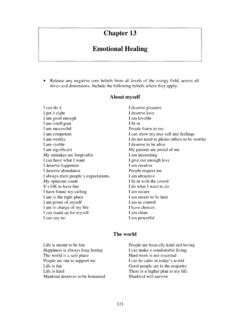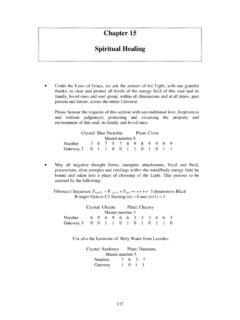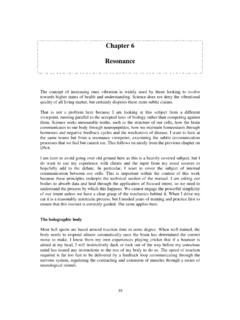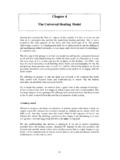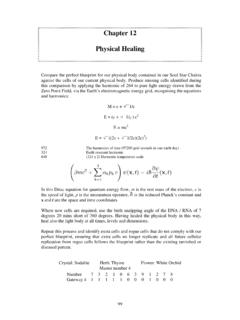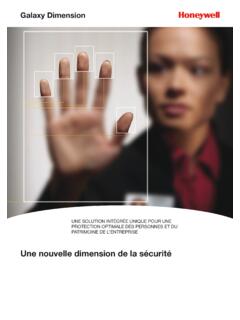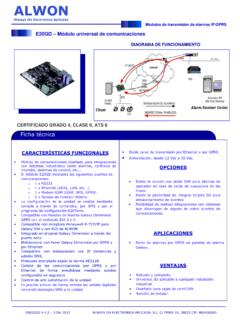Transcription of Chapter 7 - Fractal geometry - Quantum K
1 53 Chapter 7 Fractal geometry When a butterfly flaps its You will see reference to the Fibonacci sequence and occasionally the Julia set throughout the technical section of this book. This is the practical application of number sequences for the benefit of our health - not the maths we were taught at school but Fractal geometry , the maths of nature herself where straight lines simply do not exist. It is a fascinating subject. If I asked you how long you thought the coastline of Britain was, what would you say a couple of thousand miles perhaps? Try a few million miles. In fact, it is longer than that, it is infinitely long. This sounds hard to believe, but we are so used to measuring distances in straight lines that we forget how false this system is. If you walked for a few minutes along a cliff-top path you would probably cover a few hundred yards in a roughly straight line, but you would not have traced the exact boundary.
2 In reality, the edge of the path may curve gently and if you look at the rocks and sand that make it up, you will see hundreds of tiny indentations as the surface seems to weave this way and that in a seemingly random pattern. Look under a microscope and there are even more imperfections within its boundary. This concept applies right down to the atomic level, then to the Quantum level of quarks and beyond into the unknown. This is the essence of Fractal geometry the deeper you look the more you find. There is no such thing as a straight line in nature, so the path truly is unlimited in length. Furthermore, the depth of design that underpins the path, a tree, a lightening bolt, is far from random. There is a core symmetry and mathematical code that underpins all natural structures however scrambled they may look to the eye. Certain mathematical shapes and ratios are particularly suitable for life and have a structure that is both appealing to the eye and The incredible Romanesque vegetable practical for survival purposes.
3 For example, if trees and plants were any taller they could be blown over by the wind; any shorter and they might have insufficient surface area to catch the sun s rays and 54 for photosynthesis to occur. There is perfection in these seemingly random creations of nature. In mathematical terms, this explains why Fractal geometry is based on the addition rather than the multiplication of numbers. If the Fractal growth of a plant was exponential rather than incremental, it would grow too fast and its structure would fail to support its extremities. Nature cannot afford to make mistakes, so its growth is always in perfect proportion to the structural strength of what lies beneath. These shared design patterns work at many levels. The deeper you look, the more you find. We know that electrons circle the nucleus of an atom, kept in orbit by some sort of electromagnetic or gravitational field.
4 This is no more than a mini version of the way the planets orbit the sun, or the way our solar system rotates within the galaxy. These principles apply across the board, from the smallest snowflake to the largest star system. This is classic Fractal geometry , with patterns repeating over and over as we delve deeper into their shape or retreat back in a forlorn attempt to define their boundaries. As an example of self-similarity , have a look at the wonderful picture on the left and decide what you think it is my first reaction was that it is a capillary network in the human body, or perhaps the patterns on a leaf. It could be either of these, but in fact it is a photo taken by NASA of the snow-capped peaks and ridges of the eastern Himalayas. Nature s constructions follow the same basic laws whether at the micro or the macro level, one is just a bigger version of the other. As a child, I used to look at the sparks flying off a burning log on the fire and wonder if that was a star system collapsing in another and perhaps that our own solar system is nothing more than a glowing ember on the fire of some other dimension that exists on a scale way beyond the limits of our imagination.
5 I m sure we all have had similar thoughts in our time; perhaps these deep truths lie dormant within us all until we suppress them with the limited concepts of Euclidean based mathematics at school. These theoretical connections suggest that there must be some core building block, some basic mathematical principle that explains the development of a foetus in the womb, the growth of a leaf on a tree and the way planets orbit around a sun. This has been the Holy Grail of mathematicians for centuries. It appears to have eluded Einstein in his time, but modern Quantum physicists are now starting to define these unifying principles. They have found simple equations that seem to explain the 55 geometric proportions of matter and life itself, with unifying proportions that link all forms of existence. The fern on the left looks spectacular and a fine example of nature. In fact, it was created by Roger Bagula and is the result of 100,000 iterations of the mathematical formulae: xn+1 = a xn + b yn + e yn+1 = c xn + d yn + f Like all good Fractal progressions, the design is self-similar; it maintains the same proportions however deeply you look into its design.
6 Each fern leaf is a complete fern in its own right. If you want to read more on the appearance of Fibonacci progressions in Nature, my favourite website is devised by Dr Ron Knott1. It explains the maths but also has some wonderful examples and photographs of how they arise in Nature. The beauty of this type of mathematics is that the core equation is relatively simple. Just as the calculation of Pi (22/7) leads to an infinitely expanding progression, so does the expansion of a basic equation in Fractal geometry . The subject of genomes and DNA is particularly interesting in this context. We have approximately 3 billion base pairs of DNA in all of our 75 trillion cells which is an awful lot of DNA. Our genes are the interim step which determine how the DNA is replicated within our cells. Recent scientific discoveries in this new field are raising many eyebrows because it is becoming clear that most variants of life on this planet share a large percentage of our DNA.
7 How does it feel to know that we share 99% of our genes with a chimpanzee, 40% with some species of fish and 40% with a banana? You can hopefully see where I am going with this. Different life forms can be created with only the slightest tweak in the genetical make-up. The DNA that lies beneath is the ultimate Fractal expression, with a structure and strength derived from a simple but Fractal core. It is the expansion of this basic starting point that leads to individuality and the differences between all the occupants of the living world. Fractal geometry explains how this initial position can become infinitely complex and varied, giving the false impression of asymmetry, chaos and disconnection when in truth all is linked. These concepts really do explain the development of life, while leaving room for the existence of a Divine spark as the trigger behind it, if you wish to look for one. In essence, everything is connected.
8 A butterfly flapping its wings really does echo across the planet and beyond. 1 56 The mathematical building blocks of life If there really is a unifying formula that explains the creation of everything, then perhaps we can use our understanding of it to support our health. To explore this idea further, we need to look at the basic mathematics behind these principles. Our starting point must be a suitable Fractal equation, one that is easy to use but is clear enough for our body s intelligence to understand the intent behind its formation. Some fractals are based on the square root of negative numbers, which takes us further into the conceptual world than we need to travel. For this reason, the Fibonacci sequence is the perfect equation. It uses real numbers, which are easier for our bodies to interpret. This is the core design behind the equations in this manual.
9 I have occasionally used a Julia Set sequence in some areas, but only when working with concepts outside the basic functions of the human body, like blocking electromagnetic stress, or undoing the trauma of dental work. So, if we are going to use the Fibonacci sequence as our primary building block, we need to start looking at how it works. Take any two numbers you wish, say 2 and 5. Add them together and you get 7. Add the 5 and the 7 together and you get 12. 12 and 7 makes 19. Keep adding the last two numbers together and before long you have the following sequence: 2, 5, 7, 12, 19, 31, 50, 81, 131, 212, 343, 555, 898, 1453, 2351, 3804 etc As the numbers grow, you move increasingly closer to the golden ratio of approximately 1 to In other words, every subsequent number is times the previous one. I ll explain the significance of this in a minute. Lets work through another sequence first - the true Fibonacci progression which starts with 0 and 1.
10 (I like the undertones here; first there was nothing, then there was the first act of ) 0 + 1 = 1 1 + 1 = 2 1 + 2 = 3 2 + 3 = 5 3 + 5 = 8 .. and off it ..0, 1, 1, 2, 3, 5, 8, 13, 21, 34, 55, 89, 144, 233, 377, 610, 987, 1597 etc You will see that although the numbers are different, the ratio between them rapidly evolves to the golden ratio , the higher the numbers, the more accurate the correlation. The mathematical representation of this sequence of additions looks like this: F (n+2) = F(n+1) +F(n) - + All this is saying is that the third number in the sequence (n+2) is the addition of the previous two, (n+1) and (n). I have added infinity signs - + to show that the 57 Fractal should be computed in both directions, as in nature where there is no beginning or end to the depth of the calculations. I have also added the words 3 dimensions wherever the basic formula is shown, to make absolutely sure that our bodies absorb the equation as a three dimensional concept.
